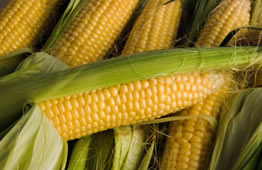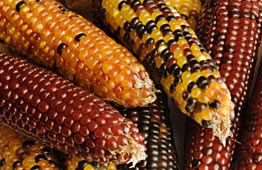Ears of Corn

Corn in Husk

Indian Corn

Ingredient Information
Corn
There are so many different varieties of corn, some used for animal feed, others for milling, and in the last few decades, many that are used for everything from plastics to high fructose corn syrup to ethanol (for drinking and running your car). There are also a myriad of others that we eat (right off the cob or not).
Popcorn, for instance, is a corn variety unto itself. The corn that we use in cooking in most recipes today, however, is referred to as sweet corn. Interestingly, Native Americans didn’t eat much of sweet corn, finding it to be too sweet and the texture too creamy. Indian corn is hardier and much coarser in texture, and Native Americans used it only for grinding (milling) into corn meal or as hominy grits.
As with apples, there used to be many different varieties of sweet corn planted in America. It has, however, become harder and harder in recent years to find more than simple white or yellow (or bicolor) corn in the grocery.
The different breeds were sought after, as there were slight variations in flavor based on how sweet the corn is. There are both yellow and white as well as combination varieties. The genetic make up of sweet corn results in increased amounts of sugars stored in the corn kernels, with more varieties of sweeter corn being engineered every year.
As soon as corn is picked, the sugars in the kernels begin to turn to starch. Consequently, the fresher the corn the better. While some vegetables hold up better to freezing, corn is only fair and you’re best off trying to use fresh corn in your recipes. When choosing fresh corn the husks should be bright green and not dry. Likewise, silks (the fine strands between the husk and the kernels) should be slightly moist and the kernels plump.
While the particular variety of corn is a good predictor of how it will taste, it is the individual farmers that are the key to good corn. I have had Silver Queen that was dry and tasteless and not altogether very sweet. As with so many ingredients in the last few years, it’s best to look for locally grown or heirloom varieties. I used to live in the country, where looking for freshly picked corn in the summer is a sport similar to hunting wild mushrooms – everybody has their favorite spot to go looking.
1 medium ear corn = 77 calories, 1 g fat, <1 g sat fat, 0.5 g mono fat, 3 g protein, 17 g carbohydrates, 14 mg sodium, 0mg cholesterol, 2 g fiber, 0 mcg Vitamin K
Related Ingredients
Recipes Using Corn
Side Dishes
Roasted Corn on the Cob
Creamed Corn
Corn and Parsnip Puree
Succotash
Soups
Corn Chowder
Steamed Clams with Spicy Tomato Corn Broth and Fettuccine
Roasted Tomato Soup with Garlic and Corn
Fish and Shellfish
Pork
Poultry
Vegetarian Main Course Recipes
Yellow Pepper and White Asparagus Soft Tacos
Soft Corn Tacos
Corn and Black Bean Taco Salad
Corn Quesadillas
Cumin, Black Eyes and Corn Salad | Low Sodium Version
Breakfast
Southwestern Frittata
Cornbread Muffins
